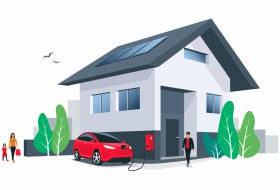Planning Application Guide
Application submission
You’ve decided you would like to submit a planning application for your proposed development. This page has all the information required to support your submission. However, a planning agent can greatly assist individuals with little or no knowledge of the planning process.
To help speed up the process, all our applicants and agents are encouraged to submit electronically.
Registration for the Planning Portal is easy and you can complete your application form, upload supporting documents and pay fees online. Please see the next page ‘Validation’ for information on what you will need to submit with your planning application.
It is important to ensure that your plans can be clearly and quickly understood. Poorly presented drawings and inadequate supporting reports, such as a design and access statement or a bat survey can often cause delays in the processing of planning applications; because clarification needs to be requested.
The Planning Portal is supported by all Local Council's in Wales.
It should be noted that this site is not run by us. If you experience any difficulties with this website please contact support@planningportal.co.uk or 0333 323 4589.
Common planning application FAQs
You can view guidance notes and apply online on each application type below:
- Householder planning consent
- Full planning consent
- Outline planning consent
- Planning permission for relevant demolition in a conservation area
- Reserved Matters
- Listed building consent
- Advertisement consent
- Lawful Development Certificate (LDC)
- Prior notification
- Removal/variation of conditions
- Approval of conditions
- Consent under Tree Preservation Orders
- Notification of proposed works to trees in conservation areas
- Non-Material Amendments
- Tree works: trees in conservation areas/subject to TPOs guidance notes (pdf)
- Hedgerow removal notice guidance notes (pdf)
- Structural Report Guidance (pdf)
The easiest way to for you to submit your planning application is online using the Planning Applications Wales website. Completing a form online ensures you are prompted to answer only questions relevant to your application. Your completed application form is sent directly to us for processing.
The Development Management Manual (annex 7) provides guidance on the information required for a valid planning application and other similar consents.
If you’d prefer to submit a paper application, you can download and print a pdf version here and return it by post to 3 Spilman Street, Carmarthen, SA31 1LE with the relevant fee. We only need one copy of your application form and the accompanying documents.
It is important that you read the accompanying help text as incorrect completion will delay the processing of your application.
You will need to download and complete an agricultural planning evaluation questionnaire when applying for planning permission for agricultural dwellings or buildings.
Pre Application
Seeking pre-application advice before you make a planning application can help to increase the chance of making a high quality planning application that is faster to process.
Householder planning
The Householder application should be used for proposals to alter or enlarge a single house, including works within the curtilage (boundary/garden) of a house.
Householder planning permission application form (.pdf)
Help to complete householder planning application (.pdf)
Householder planning & demolition in a conservation area (.pdf)
Householder planning & listed building consent (.pdf)
Help to complete a combined application for householder planning and listed building consent (.pdf)
Full planning permission
Full planning permission (.pdf)
Help to complete your full planning permission application (.pdf)
If you need to apply for two consent types, e.g. full permission and listed building consent, combined forms are available that include the questions for both application types. If you use one of these combined forms, even though you only have to complete one form, it will be treated as two applications and you will be given two application numbers, one for each type of consent.
Full planning & listed building consent (.pdf)
Help to complete a combined application for full planning and listed consent (.pdf)
Full planning & display of advertisements (.pdf)
Help to complete a combined application for full planning & display of advertisements (.pdf)
Full planning & demolition in a conservation area (.pdf)
Help to complete a combined application for full planning & demolition in a conservation area(.pdf)
Listed building consent and Demolition in a conservation area
Listed building consent (.pdf)
Help to complete a listed building consent application (.pdf)
Demolition in a conservation area (.pdf)
Help to complete a demolition in a conservation area application (.pdf)
Advertisement consent
Consent to display an advertisement (.pdf)
Help to complete a consent to display an advertisement application (.pdf)
Outline planning permission
Outline planning permission: some matters reserved (.pdf)
Help to complete outline planning permission: some matters reserved application (.pdf)
Outline planning permission: all matters reserved (.pdf)
Help to complete outline planning permission: all matters reserved application (.pdf)
Approval of reserved matters
Approval of reserved matters (.pdf)
Help to complete an approval of reserved matters application (.pdf)
Removal or Variation of condition(s)
Removal / Variation of a condition (.pdf)
Help to complete a removal / variation of a condition application (.pdf)
Discharge of condition(s)
Approval of details reserved by a condition (discharge of condition) (.pdf)
Non-material amendment
Help to complete a non-material amendment application (.pdf)
Lawful development certificates
Lawful development - existing use (.pdf)
Help to complete a lawful development: existing use application (.pdf)
Lawful development - proposed use (.pdf)
Help to complete a lawful development: proposed use application (.pdf)
Prior notification
Prior notification - building (agricultural/forestry) (.pdf)
Help to complete a prior notification - building (agricultural/forestry) application (.pdf)
Prior notification - road (agricultural/forestry) (.pdf)
Help to complete a prior notification - road (agricultural/forestry) application (.pdf)
Prior notification - excavation/waste material (agricultural/forestry) (.pdf)
Prior notification - fish tank/cage (agricultural/forestry) (.pdf)
Help to complete a prior notification - fish tank/cage (agricultural/forestry) application (.pdf)
Prior notification - demolition (.pdf)
Help to complete a prior notification - demolition application (.pdf)
Prior notification - development by telecoms operators (.pdf)
Help to complete a prior notification - development by telecoms operators application (.pdf)
Tree works to TPOs and trees in a conservation area
Tree works: trees in conservation areas/subject to TPOs (.pdf)
Help to complete a tree works: trees in conservation areas / subject to TPOs application (.pdf)
Hedgerow Removal
Hedgerow removal notice (.pdf)
Help to complete a hedgerow removal notice application (.pdf)
We would encourage all applicants to pay online at the time they submit their application. However, we also have the following payment methods available after submission:
- By Telephone - We accept credit/debit card payments. If you’d like to speak to a member of staff in the cashier's team - call 01267 228686 during office hours, 9am - 5pm.
- BACS Payment - e-mail planningregistrations@carmarthenshire.gov.uk for further details and to set up a BACS payment.
To pay for a Planning application please quote either the Planning Portal reference number PP-*** or the planning application reference number PL/00*** when making your payment.
To pay a statutory pre application enquiry fee please quote you reference number PRE/****
Our target is to provide a decision within an 8 week period or 16 weeks for Environmental Impact Assessment developments.
We consider that all applications are important, and we work hard to complete them as quickly as possible. We are constantly striving to ensure that the process is as efficient as possible.
Applicants whose submissions have not been resolved within the 8-week timeframe, which does apply to most applications, may have received a request for an extended timeframe to assess the application. However, the applicant does have the right to appeal to the Welsh Government via the Planning Inspectorate (Wales) if they do not agree to the extension of time and the original 8 week or agreed period has lapsed without a decision being made.
If you have any enquiries prior to making an application, we advise that you use the guidance on our webpages and planning portal in the first instance.
If you have submitted an application via a third party, please contact your agent or planning consultant.
If you have submitted an application independently and wish to discuss with your case officer, we ask that you request a response to your queries by submitting them by email to planningHWB@carmarthenshire.gov.uk.
Please allow up to 3 weeks from validation of your application before you contact your case officer, to enable the application to proceed.
You can track your planning application online, including viewing any comments we have received.
You do not need to own land to apply for planning permission on it. This means you can apply for permission before deciding whether to buy a piece of land. If you don’t own the land, you must serve notice on any owner(s) or interested parties concerned. The relevant notice will be available for you to complete online, under ‘ownership certificates’.
By completing this action, this will aid your application as information on land ownership is required in your planning application.
As part of your application you will need to show who owns the land/property you want to develop. If there is shared ownership you will also need to download the relevant notice.
Location and site/block plans can be purchased from any approved online Ordnance Survey map provider, such as Blackwells.
When using Ordnance Survey mapping for planning applications, the map should:
- Show OS Crown copyright as an acknowledgement.
- Show the correct licence number if you wish to print or copy maps for applications.
- Not be a Land Registry document.
- Not be used for multiple applications.
- Not be a photocopy or screen grab image.
- Not to be copied from existing OS mapping if using hand drawn maps – such as standard sheets.
Although the following specific details are not all required for an application to be registered as valid, they will assist us to understand the application. The Development Management Manual (annex 7) provides guidance on the information required for a valid planning application and other similar consents.
Location plan
- Scale 1:1250 or 1:2500.
- North point, date and drawing number.
- Outline the application property/site with a red line.
- Draw a blue line around any other land owned by the applicant, close to or adjoining the application site.
- Show the application property/site in relation to at least two named roads and surrounding buildings where possible.
Details of existing site layout
- Scale, typically 1:200 or appropriate scale to ascertain required level of detail.
- North point, date and number on plans.
- Show the whole property/site, including all buildings, gardens, open spaces and car parking.
- Any relevant assessments carried out.
Details of proposed site layout
- Scale, typically 1:200.
- North point, date and number on plans.
- Show the siting of any new building or extension, vehicular/pedestrian access, changes in levels, landscape proposals, including trees to be removed, new planting, new or altered boundary walls and fences, and new hard-surfaced open spaces.
- Show proposals in the context of adjacent buildings/environment.
- Illustrate elevation and cross-sections of the steepest elevation.
Floor plans
- Scale 1:50 or 1:100.
- In the case of an extension, show the floor layout of the existing building to indicate the relationship between the two, clearly indicating new work.
- Show floor plans in the context of adjacent buildings, where appropriate.
- In the case of minor applications it may be appropriate to combine the layout and floor plan (unless any demolition is involved).
- Include a roof plan where necessary to show a complex roof or alteration to one.
Elevations
- Scale 1:50 or 1:100 (consistent with floor plans) which include figured dimensions.
- Show every elevation of a new building or extension.
- For an extension or alteration, clearly distinguish existing and proposed elevations.
- Include details of material and external appearance.
- Show elevations in the context of adjacent buildings, where appropriate.
Cross-Sections
- Scale 1:50/1:100 (consistent with floor plans), where appropriate.
In the case of large scale or complex development proposals, models, computer-based representations, three dimensional drawings and perspectives may also be particularly useful.
Background.
The Water Resources (Control of Agricultural Pollution) (Wales) Regulations 2021 (CoAP) have been introduced to reduce losses of pollutants from agriculture to the environment by setting rules for certain farming practices. You must continue to comply with The Water Resources (Control of Pollution) (Silage and Slurry) (Wales) Regulations 2010 until 1 August 2024 (SSAFO).
Welsh Government has produced Guidance for Farmers and Land Managers:
Responsibility
Any person or persons who are the owners or occupiers (e.g. tenants, graziers) of an agricultural land holding (regardless of its size) are responsible for complying with these rules.
Compliance
Natural Resources Wales (NRW) is responsible for assessing compliance with these Regulations and it will do this by inspecting farms and checking records. For NRW to be satisfied the installation complies with the Regulations, you are likely to be asked for additional information about the size, design and construction materials used.
Requirements of the Regulations
Sufficient storage must be provided for pigs and poultry manure produced on the holding between 1 October and 1 April (6 months), and for other manures produced in a yard or building on the holding, 1 October and 1 March (5 months) plus sufficient capacity to meet the spreading restrictions of the regulations. The volume of the manure produced by the animals on the holding must be calculated in accordance with standard figures in Annex 2 of the Guidance. The calculation must also include an allowance for rainwater.
When calculating the required capacity of your steel or concrete store, you’ll need to include a minimum of 300 millimetres of freeboard. For earth-banked stores you’ll need a minimum of 750 millimetres, and you must maintain this freeboard during use. Freeboard is the vertical distance between the crest of your tank or the lowest point on your lagoon bank and the slurry surface.
Slurry tanks, reception pits, pipes and channels must be impermeable and meet the anti-corrosion standards set in British Standard 5502-50:1993+A2:2010. They should last for at least 20 years with maintenance.
They should not be within 10 metres of any inland and coastal waters e.g. streams, ditches, ponds or any pipes or culverts, should not be within 50 metres of any borehole, well or spring or within a groundwater source protection zone 1 (SPZ1) unless site-specific mitigation measures that minimise the risk to drinking water supplies have been agreed in writing with Natural Resources Wales
Planning permission
Development consisting of building and/or engineering operations will in most cases require planning permission.
Planning Requirements
Prospective applicants are advised to make a pre-application submission in order to obtain detailed site-specific advice, but the following planning considerations may apply:
- a location plan with an ordnance survey national grid reference;
- a description of the development and the reason(s) for your development proposal e.g. to support new or improved management of organic manures; to accommodate an increase in livestock numbers, or the capacity for an increase in livestock numbers through provision of additional infrastructure; to support animal welfare or legislative compliance;
- details of the current number and type of stock reared on the farm holding and any changes associated with the proposed development;
- a detailed site and design plan of the proposed development and all relevant components e.g. organic manure management facilities, effluent channels and tanks, construction materials and capacity, along with any associated pipework used to transfer slurry;
- Calculations for the farm slurry production (including dirty water); clear indications on what is directed to the proposed store. If the proposed reception pit is to be of an earth banked lagoon type structure, then permeability test results and representative soil sample results will also need to be provided together with details of investigations and results to determine the depth of the water table. Water levels should be measured during the wettest time of the year, and evidence provided that the depth of lagoon base is at least 1m above the water table in order to protect controlled waters and to facilitate ease of construction;
- details of all sensitive receptors that may be at risk from the proposed development, and evidence to demonstrate how any identified risks can be addressed;
- The impact on landscape character and visual impact within the wider landscape should be considered. In the majority of cases, the slurry store should be located within the general area of the existing farmyard and farm buildings, although this may not always be possible. Locations away from the farm complex will need to be fully justified. Cross sectional information to fully assess the cut and fill requirements of any development will be required, including any subsequent landscaping proposals;
- Development must maintain and enhance biodiversity within the natural environment. A Preliminary Ecological Appraisal is likely to be required where development is located on greenfield sites, in order to assess the biodiversity baseline for the proposed slurry store but any ancillary development such as the means of access required;
- A Tree Survey will be required if the proposal is likely to impact on any mature trees. Removal of trees and hedgerows should be avoided, but where it is unavoidable there should be clear plans to adequately compensate for any losses;
- A Drainage Statement will be required. Existing and proposed surface water drainage arrangements for managing clean water must be identified. If the area of the development exceeds 100 sqm a separate SAB Approval will be required;
- Transport of slurry should be minimised, and reception pits/umbilical systems should be used wherever possible;
- Consider the impact on the amenity of the occupants of any nearby residential property;
- A Nutrient Management Plan & Manure Management Plan should be provided. If your development is at risk of releasing atmospheric ammonia to nearby sensitive sites, then you will need to assess their impacts and demonstrate that emissions of ammonia to air and deposition on sensitive sites is acceptable i.e. An Atmospheric Ammonia Impact Screening Report.
Please note that Building Regulations approval is a separate matter from obtaining planning permission for your work. Our Building Control team can work with businesses and householders to help ensure your project runs smoothly and efficiently through the design, approval and construction processes. We also provide a free building regulation pre-application advice, if required.
'28 Day Rule’, Certificated Caravan and Camping Sites: A brief guide to what is permitted under planning law
'28 DAY RULE'
Overview
• The ‘28 Day Rule’ allows a landowner to use land for tented camping only without having to get formal
planning permission for 28 days in a calendar year.
• Please note that there are restrictions in the use of the land in this way.
Timescale Constraints
• The land cannot be used for more than 28 days in any calendar year.
• The 28 days do not have to be consecutive.
• We would advise you to record the exact dates when the land is being used.
• The 28 days is not per person or family; it is the total number of days you can use the land for the calendar year.
• Any day when a temporary structure (e.g. portable toilet) remains on site counts as one of the permitted
28 days.
Land Type Constraints
• The land must not be part of any land associated with an existing building, including house gardens, car parks, agricultural buildings and listed buildings.
• Land combined within existing caravan sites cannot be used as a 28 day site
CARAVAN EXEMPTION CERTIFIED SITES
Overview
• A camping or touring caravan exemption certificate allows a recreational organisation to camp or caravan
on land without a site licence or the need to apply for planning permission.
Caravan and Motorhome Constraints
• The land can accommodate up to five caravans and/or motorhomes at any one time.
Tent Constraints
• Typically, certificated sites will also include spaces for up to 10 tents depending on space.
• A greater number of tents can be allowed if permission is granted by the organisation issuing the certification.
Use Constraints
• The site cannot be used all year round.
• A site certificate is renewed annually.
• When the certificate expires the use of the land as a caravan site must stop.
• All caravans on the site must be removed as soon as possible.
Exempted Organisation Rallies
• Exempted organisations can hold gatherings of their members on sites for up to five days.
• Most organisations tell the Authority when and where this is happening at the start of the main season.
PERMITTED ON A '28 DAY' SITE
Tents and trailer tents
Glamping accommodation without solid bases Moveable structures on wheels or skids in connection with the use of the site, including portable toilets
Vehicles used solely for transportation to the site (cars, vans and trailers)
Land over five acres – up to three caravans can be pitched at a time. The maximum stay for each caravan is two nights
Land under five acres – only one caravan can be pitched at a time. The maximum stay for any caravan is two nights
NOT PERMITTED ON A '28 DAY' SITE
Glamping accommodation with solid bases – including but not restricted to: yurts, tipis, pods and bell tents
Any permanent structures including but not restricted to: agricultural buildings, toilet blocks, shops, laundry rooms
Mobile holiday homes, Recreational Vehicles (RVs)Temporary facilities on wheels or skids that require separate licensing, including but not restricted to: ‘burger vans’
Any electrical hook-up points and/or substantial utilities services such as stand-alone sinks uncharacteristic of agricultural fields
LEGISLATION
- Caravan Sites and Control of Development Act (1960)
- The Town and Country Planning (General Permitted Development) Order (1995)
If you have any queries please contact us on 01558 825285 or e-mail planningregistrations@carmarthenshire.gov.uk.





